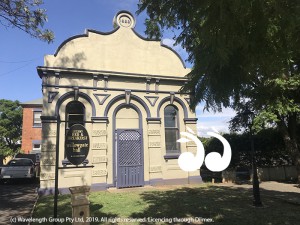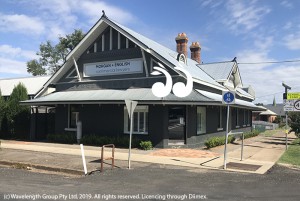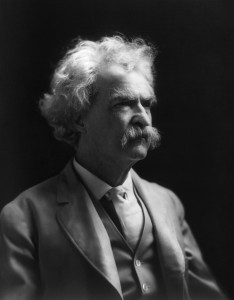Mark Twain: 1835 – 1910
Mark Twain, author of The Adventures of Huckleburry Finn, credited as the father of American literature1 and the greatest humourist America has produced2 visited Scone on December 19, 1895 as part of his world lecture tour and recounted in his book Following the Equator, A Journey Around the World.
The local School of Arts had arranged for Twain to come to Scone and had to guarantee a “very substantial sum”3 of £80. Unfortunately, ticket sales only accounted for £174 but the balance was covered by a guarantor. Mark Twain was on the world lecture tour because he owed creditors money, while he had made money from writing, he had also invested in many new inventions which weren’t so lucrative.5
He spoke at the School of Arts, which is now Willowgate Hall a bed and breakfast, at 91 Kingdon Street and stayed at the Willow Tree Hotel, which in 1895 was on the corner of Liverpool Street and Guernsey Street, now the site of Morgan and English lawyers. The Hotel was described in 1894 as, “it boasted to providing the best accommodation, an excellent sampling room for commercials, good stabling and a convenient paddock.”6
On the train trip from Sydney, via Newcastle Mr Twain spent time writing, including his observations of a man on the train who was “a slim creature, with teeth which made his mouth look like a neglected churchyard.”7
“He was a novelty – an imitation dude. He would have been a real one if he could have afforded it. But he was satisfied with himself. You could see it in his expression, and in all his attitudes and movements. He was living in a dude dreamland where all his squalid shams were genuine, and himself a sincerity. It disarmed criticism, it mollified spite, to see him so enjoy his imitation languors, and arts, and airs, and his studied daintinesses of gesture and misbegotten refinements. It was plain to me that he was imagining himself the Prince of Wales, and was doing everything the way he thought the Prince would do it. For bringing his four valises aboard and stowing them in the nettings, he gave his porter four cents, and lightly apologized for the smallness of the gratuity – just with the condescendingest little royal air in the world.”8
When Twain and his agent, Carlyle Smith, changed trains at Newcastle, Twain had a tooth extracted, before embarking on the next five-hour9 leg of the trip. It probably explains why the local newspaper reported he looked very tired when he arrived in Scone.
On the train he finished his Australian poem, A Sweltering Day in Australia, which he debuted in Scone1011 (See poem at the end of this article.) He had listed 81 Australian place names and worked 66 of them into the poem, with Murrurundi making the cut.
“These are good words for poetry. Among the best I have ever seen. There are 81 in the list. I did not need them all, but I have knocked down 66 of them; which is a good bag, it seems to me, for a person not in the business. Perhaps a poet laureate could do better, but a poet laureate gets wages, and that is different. When I write poetry I do not get any wages; often I lose money by it. The best word in that list, and the most musical and gurgly, is Woolloomoolloo. It is a place near Sydney, and is a favourite pleasure-resort. It has eight O’s in it.”12
As the train approached Scone he wrote:
December 19: Approaching Scone, wide farming and grazing levels, with pretty frequent glimpses of a troublesome plant – a particularly devilish little prickly pear, daily damned in the orisons of the agriculturalist; imported by a lady of sentiment, and contributed gratis to the colony. Blazing hot, all day.13
Mark Twain was a pen name for Samuel Langhorne Clemens and most newspaper reports of the day referred to Twain with his real name; the pen name was a rivermen’s term for water ‘two fathoms deep’ (approximately 1.8m) and considered barely safe for navigation.14
The Scone Advocate wrote of Twain’s visit to Scone:
“MARK TWAIN IN SCONE. The celebrated humorist, according to arrangement with the School of Arts committee, paid a visit to Scone yesterday. His projected tour of the Northern District having been abandoned, to Scone belongs the honour of being the only place in the northern part of the colony visited by Mr Clemens, who, as “Mark Twain” has won, and for a great many years maintained the reputation of being one of the selected few great literary characters of the English-speaking world. Mr Clemens arrived by the afternoon train from the metropolis, and as the train steamed into the station, his countenance, so faithfully depicted in the many portraits we have seen of him, was easily recognised in one of the small carriages. He was met at the station by the Mayor (Dr Scott) and Messrs, J.A.K. Shaw and E.J. Sherwood, respectively Vice President and Secretary to the School of Arts, and welcomed. He said he was very tired, and really looked it, and expressed a desire to get to his hotel (the Willow Tree) and have a rest. He had only just returned from a tour of New Zealand prior to coming to Scone, and is to lecture in Sydney tonight, where he will not arrived until after seven, so that it will seem that he does not lose much time. At the School of Arts in the evening, the audience was not as large as we expected to see, though the reserved chairs and front seats were well filled; but the back seats rarely are at lectures. Mr Shaw briefly introduced to the audience Mr Clemens, who had a flattering reception on making his appearance on the platform. He at once set to work, and the first impression was one of disappointment, when in a quiet, almost inaudible tone just as if in a quite private conversation, he proceeded to dilate and play upon incidents that crop up in life’s travels. These, of course, were the creatures of his own imagination, but each had its moral, and that’s where the real humour came in. He had not gone far before he had his audience highly amused by his droll sayings and style, and in this state he kept them to the end. Many of his jokes are best because they come suddenly and when the hearer least expects them; but the real merit of most of what he is talking about is beneath the surface. He wound up by reciting his new Australian poem, which was received with great favour.
Mr Clemens left by the 11.25 this morning for the city, where he delivers his farewell lectures tonight and tomorrow night after which he proceeds to Ceylon.”15
Twain’s tour schedule was hectic, especially considering the time it took to travel in the 1800’s on both land and sea. He had been touring Australia, before taking a trip to New Zealand, returning to Australia on December 17 and arriving in Scone on December 19. On December 20 he travelled back to Sydney to give a talk that evening and then boarded a ship for Ceylon on December 21. It was little wonder Twain was described as looking tired.
While, there were plans for Twain to visit other towns he only made it as far north as Scone and the Singleton Argus reported that while he didn’t have time for a visit they were sure he thought well of the place:
“Mr Samuel L. Clemens (Mark Twain) passed through Singleton at 3 o’clock on Thursday afternoon for Scone, where he was to lecture at night. The distinguished “American” citizen is not understood to have made any remark about Singleton which will confer immortality upon in. He is presumed to have thought of it what Sir George Dibbs did of Chicago.”16
Newcastle was left a little more confused by what Twain may have thought of their city with a quote attributed to Twain: “Newcastle consists of a long street with a graveyard at one end with no bodies in it, and a gentleman’s club at the other with no gentlemen in it.” However, the quote has not been verified with a primary source and there are other versions of the quotes in circulation. See: Why Mark Twain Lost a Tooth in Newcastle.
The Australian poem written by Mark Twain and first read in Scone:
A SWELTERING DAY IN AUSTRALIA
(To be read soft and low, with the lights turned down.)
The Bombola faints in the hot Bowral tree,
Where fierce Mullengudgery’s smothering fires
Far from the breezes of Coolgardie
Burn ghastly and blue as the day expires;
And Murriwillumba complaineth in song
For the garland bowers of Woolloomooloo,
And the Ballarat Fly and the lone Wollongong
They dream of the gardens of Jamberoo;
The wallaby sighs for the Murrubidgee,
For the velvety sod of the Munno Parah,
Where the waters of healing from Muloowurtie
Flow dim in the gloaming by Yaranyackah;
The Koppio sorrows for lost Wolloway,
And sigheth in secret for Murrurundi,
The Whangeroo wombat lamenteth the day
That made him an exile from Jerrilderie;
The Teamamute Tumut from Wirrega’s glade,
The Nangkita swallow, the Wallaroo swan,
They long for the peace of the Timaru shade
And they balmy soft airs, O sweet Mittagong!
The Kooringa buffalo pants in the sun,
The Kondoparinga lies gaping for breath,
The Kongorong Camaum to the shadow has won,
But the Goomeroo sinks in the slumber of death;
In the weltering hell of the Moorooroo plain
The Yatala Wangary withers and dies,
And the Worrow Wanilla, demented with pain,
To the Woolgoolga woodlands despairingly flies;
Sweet Nangwarry’s desolate, Coonamble wails,
And Tungkillo Kuito in sables is drest,
For the Whangerei winds fall asleep in the sails
And the Booleroo life-breeze is dead in the west.
Mypongo, Kapunda, O slumber no more
Yankalilla, Parawirra, be warned
There’s death in the air!
Killanoola, wherefore
Shall the prayer of Penola be scorned?
Cootamundra, and Takee, and Wakatipu,
Toowoomba, Kaikoura are lost
From Onkaparinga to far Oamaru
All burn in this hell’s holocaust!
Parammatta and Binnum are gone to their rest
In the vale of Tapanni Taroom,
Kawakawa, Ddeniliquin – all that was best
In the earth are but graves and a tomb!
Narrandera mourns, Cameron answers not
When the roll of the scathless we cry
Tangariro, Goodiwindi, Wollundunga, the spot
Is mute and forlorn where ye lie.
- Jelliffe, Robert A, Faulkner at Nagano, 1956, Tokyo: Kenkyusha, Ltd, cited Wikipedia: https://en.wikipedia.org/wiki/Mark_Twain, viewed April 11,2019. [↩]
- ‘Mark Twain is Dead at 74’, Obituary, New York Times, April 22, 2010, p.1. Cited NYTtimes online <http://www.nytimes.com/packages/html/books/twain-obit.pdf >, viewed April 10, 2019. [↩]
- ‘Mark Twain’, Maitland Mercury, Wednesday, December 18, 1895, p.3, cited on Trove, https://trove.nla.gov.au/newspaper/article/123929920?searchTerm=mark%20twain%20scone&searchLimits=l-australian=y, cited April 4, 2019 [↩]
- ‘Mark Twain’, Maitland Mercury, Friday, January 24, 1896, p.4. Cited on Trove https://trove.nla.gov.au/newspaper/article/123930424?searchTerm=mark%20twain%20scone&searchLimits=l-australian=y, viewed on April 9, 2019. [↩]
- Mark Twain, Wikipedia, https://en.wikipedia.org/wiki/Mark_Twain, viewed on April 6, 2019. [↩]
- W.P.Howey, ‘Mark Twain’, Scone Vet Dynasty, November 4, 2017 online: http://sconevetdynasty.com.au/mark-twain/, viewed April 6, 2019. [↩]
- Mark Twain, Following the Equator, A Journey Around the World, p.203 – first published January 1, republished September 1, 1989 by Dover Publications, cited online http://www.biblioteca.org.ar/libros/167735.pdf, viewed April 5, 2019. [↩]
- Mark Twain, Following the Equator, A Journey Around the World, p.203-204 – first published January 1, republished September 1, 1989 by Dover Publications, cited online http://www.biblioteca.org.ar/libros/167735.pdf, viewed April 5, 2019. [↩]
- The Railway Guide to NSW 3rd edition, 1886, p.19, cited on Gionni Di Gravio, Why Mark Twain Lost a Tooth in Newcastle, https://hunterlivinghistories.com/2013/07/20/why-mark-twain-lost-a-tooth-in-newcastle/, viewed on April 7, 2019. [↩]
- ‘Mark Twain’, Daily Telegraph, Saturday, Dec 21, 1895, p.10. Cited on Trove https://trove.nla.gov.au/newspaper/article/238551840?searchTerm=mark%20twain%20scone&searchLimits=l-australian=y viewed April 7, 2019. [↩]
- ‘Mark Twain in Scone’, Scone Advocate, December 20, 1895, cited on Gionni Di Gravio, Why Mark Twain Lost a Tooth, Hunter Living Histories, University of Newcastle, https://hunterlivinghistories.com/2013/07/20/why-mark-twain-lost-a-tooth-in-newcastle/ April 7, 2019. [↩]
- Mark Twain, Following the Equator, A Journey Around the World, p.208 – first published January 1, republished September 1, 1989 by Dover Publications, cited online http://www.biblioteca.org.ar/libros/167735.pdf, viewed April 5, 2019. [↩]
- Mark Twain, Following the Equator, A Journey Around the World, p.204 – first published January 1, republished September 1, 1989 by Dover Publications, cited online http://www.biblioteca.org.ar/libros/167735.pdf, viewed April 5, 2019. [↩]
- Mike Scanlon, ‘Tracking Down Twain’, Newcastle Herald, December 19, 1995, p.6. cited on Gionni Di Gravio, ‘Why Mark Twain Lost a Tooth’, Hunter Living Histories, University of Newcastle, https://hunterlivinghistories.com/2013/07/20/why-mark-twain-lost-a-tooth-in-newcastle/ viewed on April 7, 2019. [↩]
- ‘Mark Twain in Scone’, Scone Advocate, December 20, 1895, cited Gionni Di Gravio, ‘Why Mark Twain Lost a Tooth’, Hunter Living Histories, University of Newcastle, https://hunterlivinghistories.com/2013/07/20/why-mark-twain-lost-a-tooth-in-newcastle/ viewed on April 7, 2019. [↩]
- ‘Mark Twain’, Singleton Argus, Saturday, December 21, 1895, p.2. Cited on Trove: https://trove.nla.gov.au/newspaper/article/83243002?searchTerm=mark%20twain%20scone&searchLimits=l-australian=y viewed April 7, 2019. [↩]
 scone.com.au
scone.com.au

